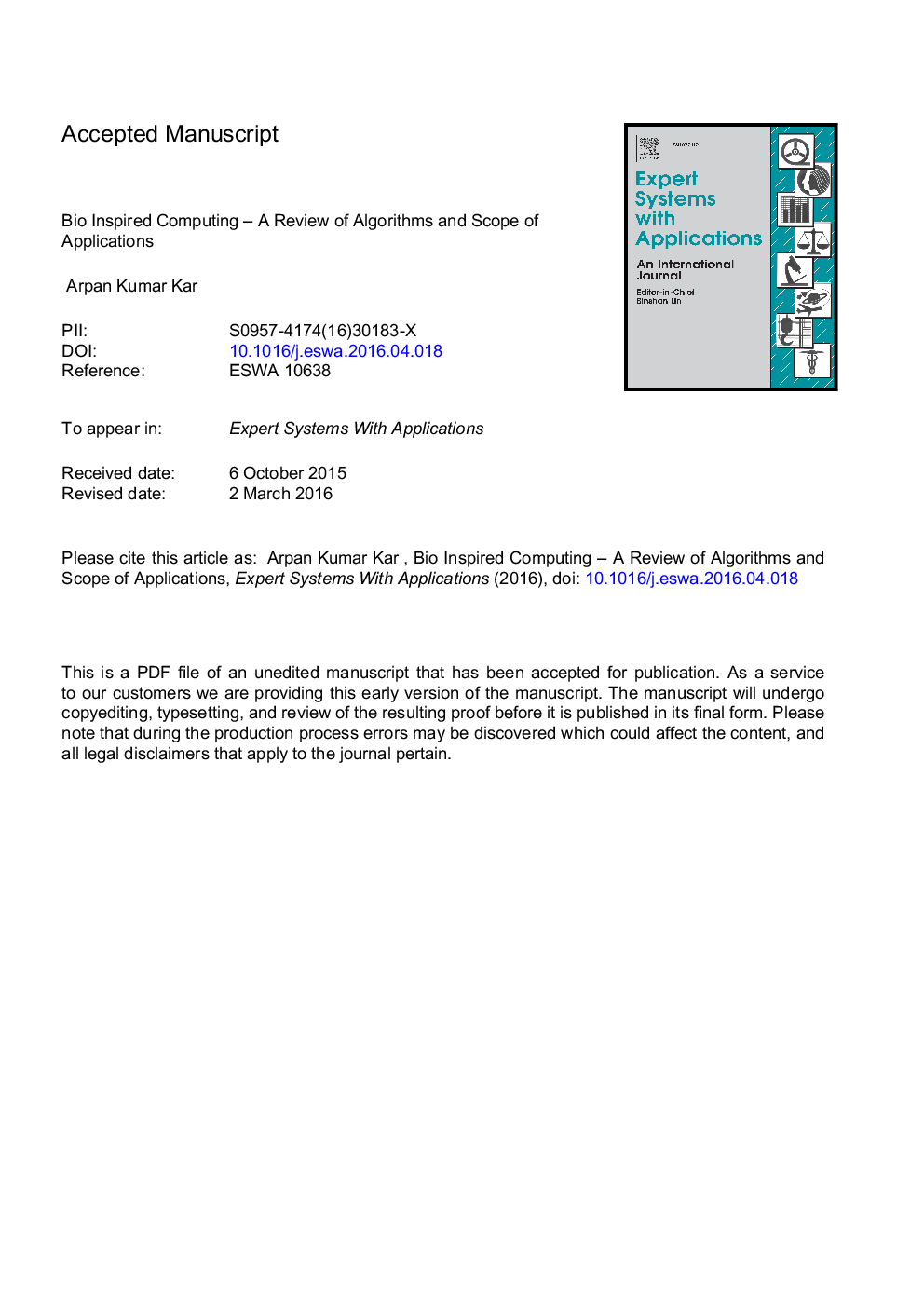| کد مقاله | کد نشریه | سال انتشار | مقاله انگلیسی | نسخه تمام متن |
|---|---|---|---|---|
| 6855667 | 660734 | 2016 | 55 صفحه PDF | دانلود رایگان |
عنوان انگلیسی مقاله ISI
Bio inspired computing - A review of algorithms and scope of applications
ترجمه فارسی عنوان
محاسبات بیرونی الهام بخش - بررسی الگوریتم ها و دامنه برنامه های کاربردی
دانلود مقاله + سفارش ترجمه
دانلود مقاله ISI انگلیسی
رایگان برای ایرانیان
کلمات کلیدی
محاسبات بیرونی الهام گرفته، هوش مصنوعی، هوشافزاری الگوریتم های هوشمند متهوریستی، بررسی ادبیات،
ترجمه چکیده
با انفجار تولید داده ها، یافتن راه حل های بهینه برای مشکلات داده ها به طور فزاینده ای تبدیل به یک چالش می شود، اگر غیرممکن باشد. به طور فزاینده ای به رسمیت شناخته شده است که برنامه های الگوریتم هوشمند الهام گرفته از زیست شناسی ضروری است برای حل مشکلات بسیار پیچیده برای ارائه راه حل های کاری در زمان، به خصوص با تعاریف مشکل پویا، نوسانات محدودیت ها، اطلاعات ناقص و یا ناقص و محدودیت محاسبات ظرفیت. بنابراین، چنین الگوریتم های هوشمندانه ای بیشتر برای حل مسائل پیچیده پیچیده مورد بررسی قرار می گیرند. در حالی که برخی مطالعات در حال بررسی کاربرد این الگوریتم ها در یک زمینه نوین هستند، مطالعات دیگر به طور پیوسته بهبود الگوریتم خود را دارند. با این حال، رشد سریع در دامنه باعث می شود محققان از پیشرفت ها در رویکردهای مختلف بی اطلاع باشند و از این رو آگاهی در مورد الگوریتم ها به طور فزاینده ای کاهش می یابد؛ به این ترتیب ادبیات مربوط به محاسبات الهام گرفته از بیوفیزیکی تنها به چند الگوریتم تقلیل می یابد (مثل شبکه های عصبی، الگوریتم های ژنتیک، ذرت و بهینه سازی کلنی). برای رفع این نگرانی، الگوریتم های محبوب مورد استفاده در حوزه الگوریتم های الهام گرفته از زیست شناسی را شناسایی می کنیم و اصول، تحولات و حوزه کاربرد آنها را مورد بحث قرار می دهیم. به طور خاص، ما در مورد شبکه های عصبی، الگوریتم ژنتیک، پارگی ذرات، بهینه سازی کلنی مورچه، کلونی مصنوعی زنبور عسل، نگهداری باکتری ها، جستجوی کوکو، کرم شب تاب، قورباغه پرش، الگوریتم خفاش، گرده گل و الگوریتم بهینه سازی گیاه مصنوعی مورد بحث قرار گرفته است. اهداف دیگر که می توانند توسط این دوازده الگوریتم مورد توجه قرار گیرند، نیز شناسایی و مورد بحث قرار می گیرند. این بررسی مسیر مطالعات آینده را برای انتخاب الگوریتم های مبتنی بر اتصالات، هموار می کند. ما همچنین دیگر الگوریتم های الهام گرفته از زیست شناختی را شناسایی کرده ایم، جایی که محدوده وسیعی در توسعه و برنامه نویسی تئوری وجود دارد به دلیل عدم وجود ادبیات قابل توجه.
موضوعات مرتبط
مهندسی و علوم پایه
مهندسی کامپیوتر
هوش مصنوعی
چکیده انگلیسی
With the explosion of data generation, getting optimal solutions to data driven problems is increasingly becoming a challenge, if not impossible. It is increasingly being recognised that applications of intelligent bio-inspired algorithms are necessary for addressing highly complex problems to provide working solutions in time, especially with dynamic problem definitions, fluctuations in constraints, incomplete or imperfect information and limited computation capacity. More and more such intelligent algorithms are thus being explored for solving different complex problems. While some studies are exploring the application of these algorithms in a novel context, other studies are incrementally improving the algorithm itself. However, the fast growth in the domain makes researchers unaware of the progresses across different approaches and hence awareness across algorithms is increasingly reducing, due to which the literature on bio-inspired computing is skewed towards few algorithms only (like neural networks, genetic algorithms, particle swarm and ant colony optimization). To address this concern, we identify the popularly used algorithms within the domain of bio-inspired algorithms and discuss their principles, developments and scope of application. Specifically, we have discussed the neural networks, genetic algorithm, particle swarm, ant colony optimization, artificial bee colony, bacterial foraging, cuckoo search, firefly, leaping frog, bat algorithm, flower pollination and artificial plant optimization algorithm. Further objectives which could be addressed by these twelve algorithms have also be identified and discussed. This review would pave the path for future studies to choose algorithms based on fitment. We have also identified other bio-inspired algorithms, where there are a lot of scope in theory development and applications, due to the absence of significant literature.
ناشر
Database: Elsevier - ScienceDirect (ساینس دایرکت)
Journal: Expert Systems with Applications - Volume 59, 15 October 2016, Pages 20-32
Journal: Expert Systems with Applications - Volume 59, 15 October 2016, Pages 20-32
نویسندگان
Arpan Kumar Kar,
